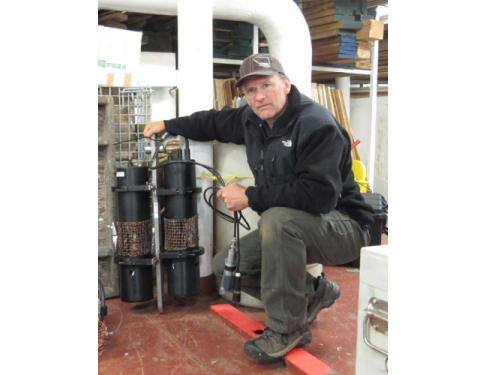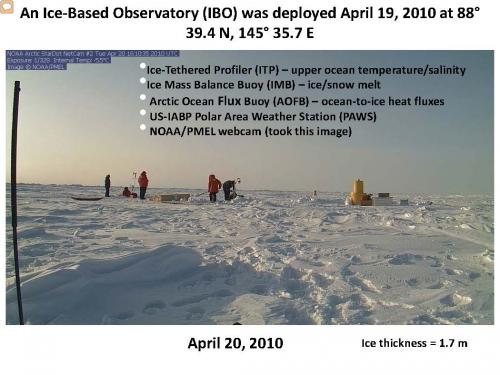First News
We are headed to Barrow... Alaska that is. Normally when I think of going to Barrow I think of it in terms of approaching from the south-something like Missoula to Seattle to Anchorage to Fairbanks to Barrow gets you there. But we are approaching from the north and truth be told I will not actually set foot in Barrow (not that I have set foot there before approaching from the south either). The BL (Barrow Line) section was finished up early this morning and now we are headed west towards Barrow with an ETA of noon. We are to pick up batteries and some fresh vegetables but because of various US Customs restrictions, only the helicopter pilot will go to Barrow. The rest of us will watch. Once we have finished our business in Barrow we will turn north and hit a couple of stations that were added to the plan since we were in the area. One of those stations sits at the entrance to the Bering Strait and a sample will be taken which will be analyzed for Caesium 137/134, the isotopes which can be traced to the Fukushima Nuclear Power Plant Disaster of 2011. If it is present, then that would be evidence of radioactive release beginning to make its way into the Beaufort Sea from the Pacific Ocean. On a side note, the amount of Caesium 137/134 found in seawater samples is so low it barely registers as being detectable. So, once we have completed the added stations, our course will turn to the east and back to the Mooring A Station for redeployment. Then we will continue east to Mooring Station D and eventually head back south towards Kugluktuk our take out point.
Chemistry Timeout
The DIC Analysis covered last time is one way to get a handle on how much carbon dioxide is dissolved in a seawater sample. It relies on getting the carbon dioxide that is trapped as carbonate to be released, so in some ways it is an indirect measurement. A more direct measurement is to allow the CO2 that is not tied up as carbonate to cross a gas permeable membrane and equalize with the CO2 in an indicator solution. Since the indicator solution has essentially no CO2 dissolved in it, the CO2 in the seawater will move across the membrane into the indicator solution because the partial pressure of CO2 is higher in the seawater. Once in the indicator solution, the CO2 causes a pH change and the indicator solution will change color. Light is passed through the indicator solution and the more light that is absorbed by the indicator solution, the more CO2 in the seawater. Since we know how much CO2 it takes to cause specific light absorbance (think Beers' Law here) we then know how much CO2 must be in the seawater to begin with. Pretty slick eh?
Mike DeGrandpre from the University of Montana (UM) has taken this a step further. He designed and built an instrument called a SAMI (Submersible Autonomous Moored Instrument) that puts all the necessary apparatus for this into a water-tight box. It is connected to a small computer (also in the box) and with the use of a small pumps and small bags of the necessary chemicals, it can be deployed in any body of water and collect data about the concentration of CO2 continuously for over a year at a time. When the SAMI is recovered, its stored data can be downloaded to an external computer allowing for a large number of samples to be taken from one place without having to be there or repeatedly visit the spot and take samples back to the lab for analysis. He also has a similar instrument for measuring the changes in pH of water. Both the sensors are often deployed in pairs so that both parameters can be measured simultaneously. If you think about this in terms of "direct observation" SAMI's serve as tools for direct observation without actually having to be there 24-7-365!
Icebreaker’s news from US Arctic Research Commission September 22, 2017
Defense Bill Passes US Senate with Provisions for Icebreakers, Alaska Missile Defense. The U.S. Senate on Monday passed a $692 billion defense authorization bill that included provisions to bolster missile defense systems in Alaska and approval for building up to six Arctic icebreakers. The Alaska provisions are a mark of success for the state's lawmakers, who have long pushed for the provisions. But seeing them through to reality will require Congress to manage the full scope of appropriations bills in the coming year – something that happens rarely. Read more: https://www.arcticnow.com/politics-policy/2017/09/19/defense-bill-passes-us-senate-with-provisions-for-icebreakers-alaska-missile-defense
Russia Floats Out Powerful Nuclear Icebreaker
Russia on Friday held a launching ceremony for a powerful nuclear icebreaker, called Sibir (Siberia), in its drive to prepare a fleet for navigating the Northern Passage and hauling goods, particularly energy, to Asian markets. The massive new ship measures 173 metres in length and has two nuclear reactors with the propulsion power of 60 megawatts. Read more: https://phys.org/news/2017-09-russia-powerful-nuclear-icebreaker.html#jCp
Coast Guard Cutter Returns to Hawaii from Arctic Deployment
The Honolulu-based Coast Guard cutter Sherman returned Wednesday after a 94-day, 16,000 mile patrol in the Arctic Ocean and Bering Sea in a region where melting sea ice is causing commercial and military activity to heat up as well. During the patrol the crew conducted community outreach, fisheries law enforcement, search and rescue, joint military work and national security missions, the Coast Guard said. Read more: http://www.military.com/daily-news/2017/09/22/coast-guard-cutter-returns-hawaii-arctic-deployment.html
Toward an effective and sustained Arctic marine Observing system
The idea to observe physical and biological conditions of the Arctic’s atmosphere, ice, and ocean from drifting sea ice is not new. It has been utilized by generations of people starting as far back as in the 16th century when intentionally or non-intentionally their boats have been frozen in sea ice and drifted with it long distances (read about history of Arctic exploration at our website www.whoi.edu/beaufortgyre). Among the most famous and scientifically sound expeditions were drifts of Nansen’s vessel Fram and more than 45 so called “North Pole” drifting stations, and drifting station “T3”.
In the 21st century, the rapid changes in key environmental parameters show the importance of a sustained environmental Arctic monitoring system targeted to address specific scientific questions and employing automated instrumentation systems. Such an autonomous observing system is less costly than drifting stations and less hazardous to people limited in their work by severe climate conditions. In addition, automated systems enable long term measurements to be made at multiple locations. Thus, the traditional approach of acquiring observations when and where the Arctic is accessible can be enhanced and in the future replaced with multi-faceted measurement systems operating autonomously to provide year-round information in real time.
The major goal of such a network of autonomous sensors is to measure and monitor physical, chemical and biological parameters at least daily intervals year round. It is also important to transfer measurements in real time to data centers via satellites. The Ice-based Observatories (IBOs) initiated by Woods Hole Oceanographic Institution in collaboration with researches from US Army Cold Regions Research and Engineering Laboratory, Naval Postgraduate School, NOAA/PMEL, and other institutions is a successful example and prototype for Arctic monitoring by autonomous instruments. Graphs 9 and 10 show some details and results about an IBO deployed at the North Pole in 2010.
 Our location.
Our location.
 Mike with SAMI. Mike DeGrandpre (University of Montana) with a pair of SAMI's ready for a mooring deployment in the Arctic. (David Jones).
Mike with SAMI. Mike DeGrandpre (University of Montana) with a pair of SAMI's ready for a mooring deployment in the Arctic. (David Jones).
 SAMI pair deployment. A Pair of SAMI's being lowered into the Beaufort Sea on a mooring. (David Jones).
SAMI pair deployment. A Pair of SAMI's being lowered into the Beaufort Sea on a mooring. (David Jones).
 A SAMI. A SAMI on display. (Courtesy of Sunburst Sensors)
A SAMI. A SAMI on display. (Courtesy of Sunburst Sensors)
 The SAMI CO2 system. A schematic of the internals of a SAMI-CO2. (Courtesy of Sunburst Sensors)
The SAMI CO2 system. A schematic of the internals of a SAMI-CO2. (Courtesy of Sunburst Sensors)
 Arctic Birds. A flock of birds of the coast of Alaska near Barrow. (David Jones).
Arctic Birds. A flock of birds of the coast of Alaska near Barrow. (David Jones).
 Barrow from the ship. Barrow Alaska in the distance from the deck of the CCGS Louis S. St. Laurent. (David Jones).
Barrow from the ship. Barrow Alaska in the distance from the deck of the CCGS Louis S. St. Laurent. (David Jones).
 The chopper heads to Barrow. The ship’s helicopter in flight headed for Barrow Alaska.
The chopper heads to Barrow. The ship’s helicopter in flight headed for Barrow Alaska.
 The IBO included a Woods Hole Oceanographic Institution Ice-Tethered Profiler (ITP), a US Army Cold Regions Research and Engineering Laboratory Ice Mass Balance Buoy (IMB), a Naval Postgraduate School Arctic Ocean Flux Buoy (AOFB), and a NOAA/PMEL web camera. The combined ITP and IMB instrumentation allows us to estimate the surface ocean freshening due to ice and snow melt. From Timmemans et al., 2012 (see www.whoi.edu/itp references)
The IBO included a Woods Hole Oceanographic Institution Ice-Tethered Profiler (ITP), a US Army Cold Regions Research and Engineering Laboratory Ice Mass Balance Buoy (IMB), a Naval Postgraduate School Arctic Ocean Flux Buoy (AOFB), and a NOAA/PMEL web camera. The combined ITP and IMB instrumentation allows us to estimate the surface ocean freshening due to ice and snow melt. From Timmemans et al., 2012 (see www.whoi.edu/itp references)
 Here is a map showing the drift track and salinity at 10 m (measured by the ITP). We defined the 2010 melt season by the initiation and end of ice base ablation measured by the IMB to be between June 25 and September 7, 2010, shown by the thick arrows in the plot. Over the course of the 2010 melt season the IBO drifted about 500 km south, beginning in late June when it turned off the Lomonosov Ridge axis around 88˚N. From Timmemans et al., 2012 (see www.whoi.edu/itp references)
Here is a map showing the drift track and salinity at 10 m (measured by the ITP). We defined the 2010 melt season by the initiation and end of ice base ablation measured by the IMB to be between June 25 and September 7, 2010, shown by the thick arrows in the plot. Over the course of the 2010 melt season the IBO drifted about 500 km south, beginning in late June when it turned off the Lomonosov Ridge axis around 88˚N. From Timmemans et al., 2012 (see www.whoi.edu/itp references)

Comments
Add new comment